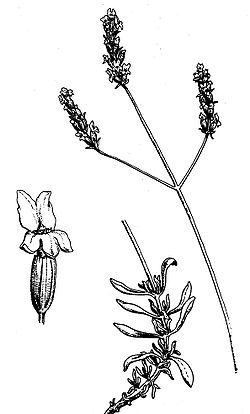| Lavandula latifolia Spike lavender | |
|---|---|
 | |
| Scientific classification | |
| Kingdom: | Plantae |
| Clade: | Tracheophytes |
| Clade: | Angiosperms |
| Clade: | Eudicots |
| Clade: | Asterids |
| Order: | Lamiales |
| Family: | Lamiaceae |
| Genus: | Lavandula |
| Species: | L. latifolia |
| Binomial name | |
| Lavandula latifolia | |
| Synonyms | |
| |

Lavandula latifolia, known as broadleaved lavender, [3] spike lavender, aspic lavender or Portuguese lavender, is a flowering plant in the family Lamiaceae, native to the western Mediterranean region, from central Portugal to northern Italy (Liguria) through Spain and southern France. Hybridization can occur in the wild with English lavender (Lavandula angustifolia).
Contents
The scent of Lavandula latifolia is stronger, with more camphor, and more pungent than Lavandula angustifolia scent. For this reason the two varieties are grown in separate fields.
